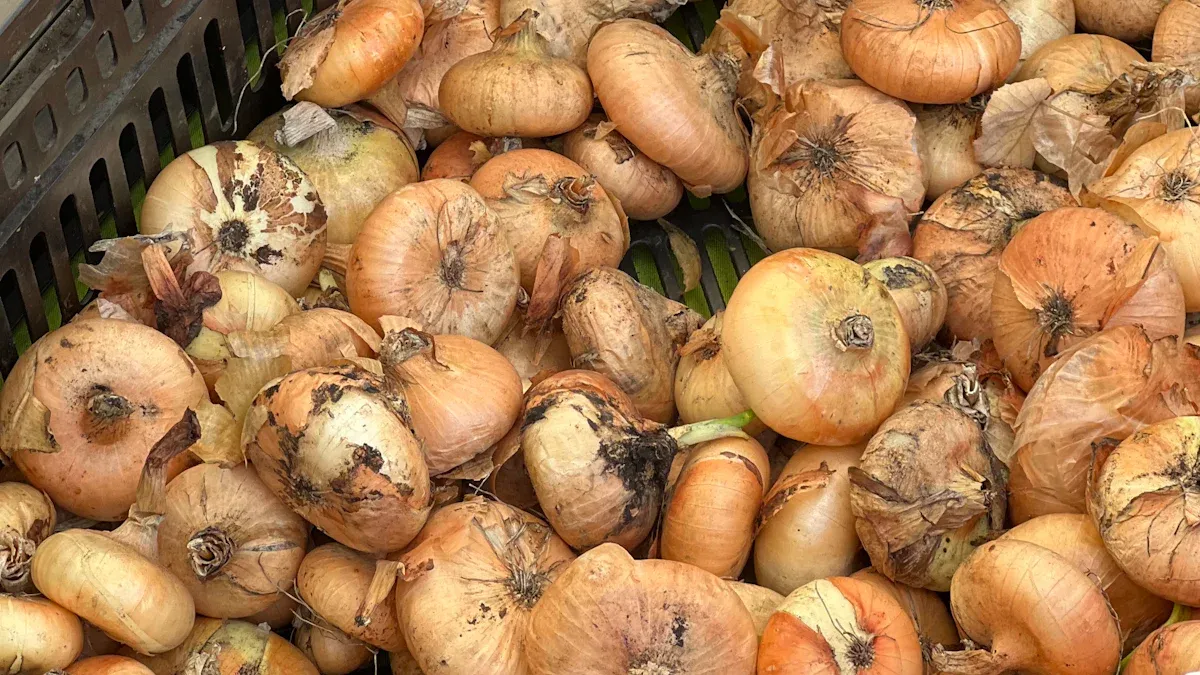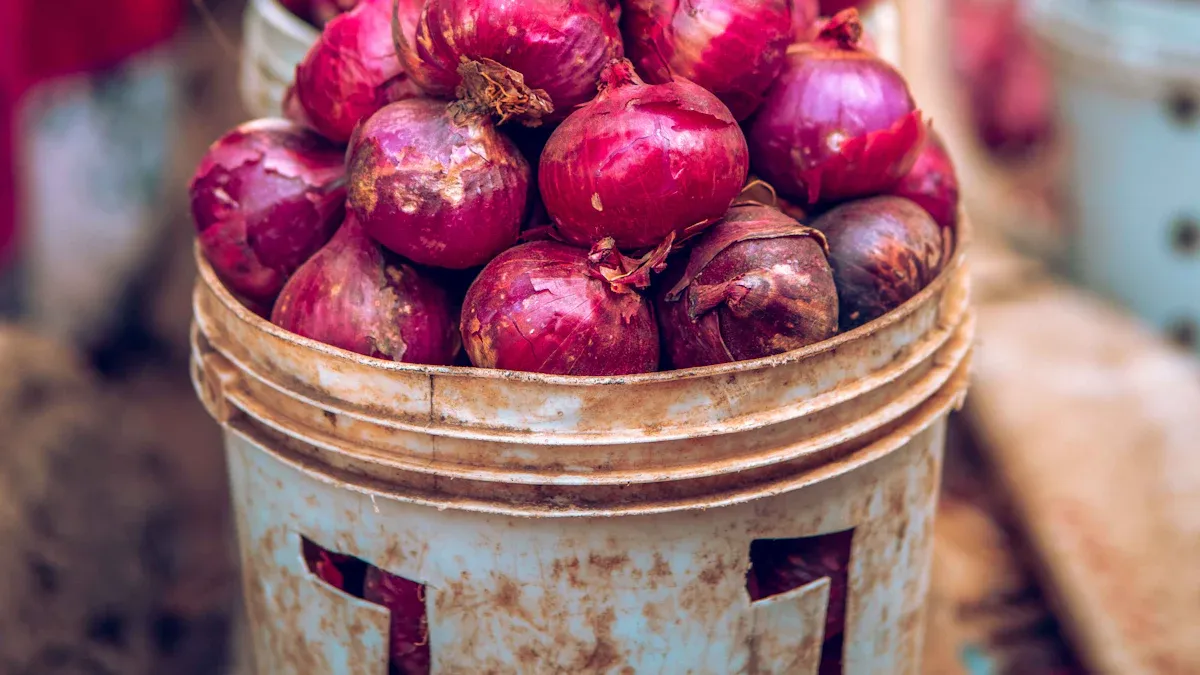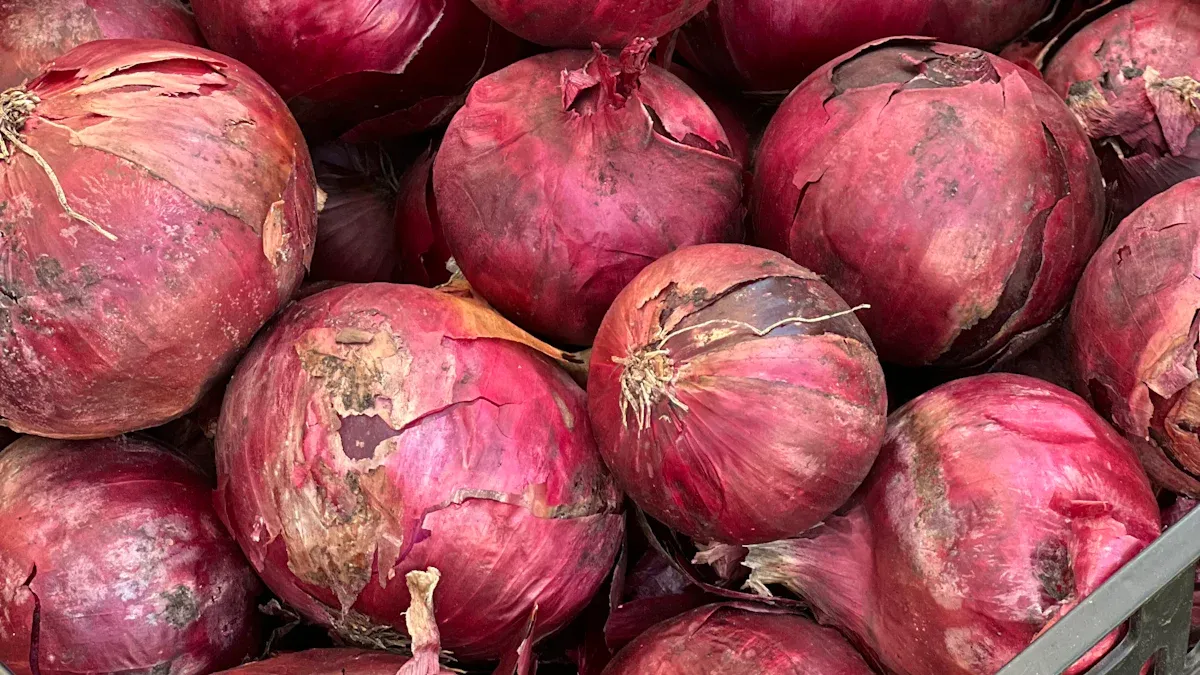A Complete Guide to Onion Cold Storage Solutions in 2025

Onion cold storage is important for keeping onions fresh in 2025. Every year, 28 lakh tonnes are needed, but 34 lakh tonnes are grown. After harvest, 25-30% of onions go bad, causing big losses. These losses cost over Tk2,000 crore yearly and lead to importing six lakh tonnes of onions. Cold storage reduces spoilage, keeping onions available and cutting waste. It also helps keep prices steady, helping farmers and buyers. This guide explains how new storage methods can help.
Key Takeaways
Storing onions in cold places stops them from spoiling quickly.
Keeping the right temperature and moisture helps onions stay fresh.
Spending on better storage can save money by cutting waste.
Checking and cleaning storage often keeps it working well and pest-free.
Smart tools can help watch storage and stop onions from going bad.
Why Onion Cold Storage Matters
Benefits of Onion Cold Storage
Keeping onions fresh and reducing waste.
Cold storage helps keep onions fresh after they are picked. Without it, onions spoil fast and can't be used. The right storage conditions make onions last much longer. This means less waste and more onions for everyone. Farmers and sellers save money and resources. They can also sell better-quality onions to buyers.
Balancing supply and prices.
Cold storage keeps the onion supply steady all year. Stored onions can be sold even when it's not harvest time. This stops sudden price increases and shortages. Both buyers and sellers benefit from stable prices. Using cold storage creates a fairer and more reliable market.
Economic and Environmental Benefits
Cutting down on food waste.
Food waste is a big problem, and onions are often wasted. Bad storage causes tons of onions to rot every year. Cold storage keeps onions in good shape and reduces waste. Less waste saves money and protects resources like water and energy used to grow onions.
Helping sustainable farming.
Good onion storage supports eco-friendly farming. It reduces waste and uses resources wisely. Many cold storage systems use energy-saving technology. This lowers harm to the environment. Cold storage is key to a greener and more sustainable food system.
Key Factors in Onion Cold Room Storage
Onion Cold Storage Temperature
Best temperatures for different onion types.
Keeping onions at the right temperature is very important. Different onions need specific temperatures to stay fresh. Dry bulb onions should be stored at 32°F (0°C). Green onions need slightly warmer temperatures, around 32-36°F (0-2°C). A steady temperature stops onions from spoiling and helps them last longer. Check the storage temperature often to avoid changes that could ruin your onions.
Humidity Control
Stopping onions from drying out or sprouting.
Humidity is very important for storing onions. If it's too low, onions lose water and shrink. If it's too high, onions can sprout or grow mold. To avoid these problems, keep humidity between 65-70%. This keeps onions firm and fresh while reducing waste. Use a hygrometer to measure and adjust humidity levels as needed.
Ventilation and Airflow
Preventing mold and keeping air moving.
Good airflow is crucial for storing onions properly. Without it, heat and moisture can build up, causing mold and rot. Make sure your storage has proper ventilation to keep onions dry and fresh. Arrange onions so air can move around them easily. Fans or ventilation systems can help improve airflow and protect your onions.
Storage Duration
Tips for short-term and long-term onion storage
Storing onions for different times needs careful thought. Think about the onion type and how you’ll use it. Short-term storage is for onions you’ll sell or use soon. Long-term storage is for keeping onions fresh for months.
For short-term storage, keep onions in a cool, dry spot. The temperature should be 50°F to 60°F (10°C to 15°C). Don’t stack onions too high, so air can flow. Check onions often for damage or rot. Remove bad onions quickly to stop rot from spreading.
Long-term storage needs stricter conditions. Use a cold room to keep the temperature at 32°F (0°C). Keep humidity between 65% and 70% to stop drying or sprouting. Store onions in mesh bags or crates for better airflow. Check the storage often to keep conditions steady.
Tip: Always dry onions before storing them for a long time. Drying the outer layers removes moisture and helps them last longer.
By following these steps, your onions will stay fresh and high-quality. Whether for short or long storage, the right care keeps onions ready to sell and reduces waste.
Types of Onion Cold Storage Solutions

Traditional Storage Systems
Basic refrigeration units
Basic refrigeration units are simple ways to store onions. They use cooling to keep a steady temperature, helping onions stay fresh. These units are good for small onion storage or part of bigger setups. They are cheap and easy to use but lack features like humidity control. Use them for short-term storage when freshness is most important.
Bulk storage facilities
Bulk storage facilities are for storing large amounts of onions. They can hold many onions, making them great for businesses. These facilities often have several cold units for different onion types. Good airflow and temperature control keep onions fresh and high-quality. For big storage needs, bulk facilities are a smart and cost-saving choice.
Advanced Storage Systems
Controlled atmosphere storage
Controlled atmosphere storage is a high-tech way to store onions. It changes oxygen, carbon dioxide, and nitrogen levels to slow aging. This keeps onions fresh for a long time. It’s perfect for long-term storage and ensures top-quality onions. Though it costs more to set up, it’s worth it for large-scale use.
Modular cold rooms
Modular cold rooms are flexible onion storage options. You can change their size and features to fit your needs. They offer exact control of temperature and humidity, keeping onions in great shape. These rooms are ideal for growing businesses. They also save energy, making them an eco-friendly storage choice.
Emerging Technologies
IoT-enabled monitoring systems
IoT-enabled systems use smart tech to monitor onion storage. They track temperature, humidity, and other conditions in real time. Alerts warn you if something goes wrong, so you can act fast. This keeps onions fresh and reduces waste. If you want modern storage, IoT systems are a great addition.
Renewable energy-powered storage
Renewable energy storage uses solar or wind power for cold storage. This cuts down on electricity use and lowers costs. It’s better for the environment and keeps onions fresh. Using renewable energy makes your storage project green and efficient.
Tip: Mix advanced storage systems with new tech to save energy and reduce waste in your onion storage.
Designing an Efficient Onion Cold Storage System
Storage Capacity Planning
Choosing the right size for your storage.
The first step is planning how much space you need. Think about how many onions you will store at once. Also, consider the type of onions and how long they’ll stay. Long-term storage needs more room than short-term storage. Plan for future growth too. A small unit might not work later as your business grows.
Use stackable crates or mesh bags to save space. These allow air to flow and fit more onions in less area. If unsure about size, ask experts or use online tools to help. Good planning stops overcrowding, which can spoil onions.
Energy Efficiency
Saving energy with smart choices.
Saving energy lowers costs and helps the environment. Pick insulation that keeps the cold inside. This reduces how hard the cooling system works. Use LED lights because they use less power and make less heat.
Buy energy-efficient cooling systems. These use less electricity but still keep onions fresh. Solar panels or other renewable energy can cut costs even more. Focusing on energy efficiency saves money and helps the planet.
Tip: Check your cooling system often for leaks or problems. Small issues can waste energy over time.
Automation and Smart Systems
Using smart tools for better storage.
Automation makes onion storage easier and better. Smart systems watch temperature and humidity all the time. They adjust settings automatically to keep onions fresh. This avoids mistakes and keeps quality steady.
Remote monitoring lets you check storage conditions from anywhere. Alerts warn you if something goes wrong, so you can fix it fast. Automation saves time and makes your storage system more reliable.
Note: Automation costs more at first but saves money later by cutting labor and waste.
Cost Considerations
Balancing upfront costs with future savings
When setting up an onion cold storage, think about costs. The starting price may seem high, but it pays off later.
First, look at the main expenses. These include building or buying the storage, adding cooling systems, and installing features like humidity control. Advanced tools, like IoT systems or renewable energy, cost more at first. But they can lower running costs over time.
Tip: Treat your storage as a long-term plan. Spending more now on energy-saving tools can cut electricity bills for years.
Running costs are also important. Energy, repairs, and labor can get expensive. Using energy-saving equipment, like LED lights and good insulation, helps save money. Automation tools reduce labor by handling tasks automatically.
To see savings, compare spoilage costs without storage to storage costs. Stored onions last longer, stay fresh, and waste less. This means more profits and fewer losses from price changes.
Example: If 20% of your onions spoil yearly, cold storage could save you thousands.
By balancing upfront costs with future savings, you can save money. Focus on quality and efficiency to keep onions fresh and ready to sell.
Latest Innovations in Onion Cold Storage for 2025

Smart Monitoring Systems
Tracking temperature and humidity easily
Smart systems are changing how onions are stored. Sensors check temperature and humidity all the time. You can see storage details on your phone or computer. Alerts warn you if something changes, so you can act fast. This keeps onions fresh and reduces waste. Using smart systems makes storage simple and effective.
Tip: Pick systems that work with your current storage setup.
AI and Machine Learning
Fixing problems before they happen
AI and ML make storage smarter and more reliable. They study data to predict when repairs are needed. For example, they can warn you if cooling might fail soon. AI also adjusts storage settings like temperature automatically. This keeps onions fresh and saves energy costs.
Example: AI might notice a small temperature rise and fix it fast.
Sustainable Solutions
Using solar power for storage
Solar-powered units are a green way to store onions. Solar panels make electricity, cutting down on regular power use. These units are great for places with little electricity. Solar power lowers costs and helps the environment while keeping onions fresh.
Safer refrigerants for the planet
New refrigerants are better for the environment. Old ones can harm nature, but HFOs are safer and work well. They keep onions at the right temperature without hurting the planet. Switching to these refrigerants makes storage eco-friendly.
Note: Combine solar power and safe refrigerants for greener storage.
Maintenance and Best Practices for Onion Cold Storage
Regular Inspections
Checking equipment for damage.
Regular checks keep your onion storage working well. Look at cooling systems, fans, and sensors for any damage. Broken equipment can change temperatures and ruin onions. Check for cracks or leaks that might harm insulation. Listen for strange noises or vibrations in machines, as these could mean problems.
Make a checklist to stay organized during inspections. Do these checks weekly or monthly based on your storage size. Finding issues early saves money and keeps onions fresh and good quality.
Cleaning and Hygiene
Stopping pests and keeping storage clean.
Clean storage is key to keeping onions fresh. Dirt can bring pests, and dirty surfaces may cause contamination. Sweep and mop floors often to remove dust and spills. Wash crates and shelves before putting onions on them.
Use pest control to keep bugs and rodents out. Seal gaps or holes in the storage area to block pests. Throw away spoiled onions quickly to stop pests and rot from spreading. Clean storage keeps onions safe and ready to eat.
Staff Training
Teaching proper onion care.
Your workers are important for keeping onions in good shape. Train them to handle onions gently to avoid damage. Show them how to check and control temperature and humidity.
Teach them how to arrange onions for good airflow. Help them spot spoiled onions and remove them fast. Well-trained workers make sure your storage runs smoothly and onions stay fresh.
Emergency Preparedness
Backup power systems and contingency plans
Emergencies can harm your onion storage, causing waste and money loss. Being ready helps keep onions fresh during unexpected problems.
Having a backup power system is very important. Power cuts can change temperatures, spoiling onions fast. A generator gives power right away if electricity stops. Pick a generator that fits your storage's energy needs. Solar-powered backups are another choice. They are better for the planet and use less regular electricity.
You also need a plan for handling emergencies well. First, find possible risks like broken equipment or bad weather. Make a clear guide for your team to follow in these cases. Give each worker a role to act quickly. For example, one person can check temperature changes, and another can call for repairs.
Practice drills often to keep your team ready. Try out emergency plans to find weak spots. Update the plan when new problems arise. Keep important tools, like thermometers and repair kits, nearby. These tools help fix small problems before they get worse.
Tip: Keep emergency phone numbers for repair workers and suppliers easy to find.
By using backup power and having a strong plan, you protect your onions from sudden issues. These steps save money and keep onions fresh for selling.
Onion cold storage helps keep onions fresh and reduces waste. This guide shows how modern storage keeps onions available all year. Using better systems lowers spoilage, saves money, and helps the food supply. Farmers and businesses can benefit by improving their storage methods. Upgrading storage is a smart move for lasting success.
FAQ
1. What is the best temperature to store onions?
Store dry bulb onions at 32°F (0°C). Green onions need 32-36°F (0-2°C). These temperatures stop spoilage and keep onions fresh longer. Use a thermometer to check the temperature often.
Tip: Keep the temperature steady to protect onion quality.
2. How do you stop onions from sprouting in storage?
Keep humidity between 65-70%. This level prevents sprouting and keeps onions firm. Use a hygrometer to check and adjust humidity as needed.
Note: Good airflow also helps stop sprouting problems.
3. Are solar-powered cold storage systems dependable?
Yes, solar-powered systems are reliable and eco-friendly. They lower electricity costs and provide steady cooling. Pick systems that match your storage size and energy needs.
Example: Solar panels can power storage even in faraway places.
4. How often should onion storage equipment be checked?
Check equipment weekly or monthly. Look for damage in cooling systems, fans, and sensors. Fixing problems early avoids spoilage and costly repairs.
Tip: Use a checklist to make inspections easier.
5. Can smart tools make onion storage better?
Yes, smart tools make managing storage easier. They watch temperature and humidity and adjust settings automatically. This saves time and reduces waste.
Emoji: 🛠️ Smart tools also cut labor costs and improve storage reliability.
See Also
Seven Groundbreaking Developments in Cold Storage Solutions
Addressing Storage Issues with Versatile Cold Storage Options
Understanding Cold Storage Functionality and Its Importance
Restaurant Cold Rooms: Effective Solutions for Storage Issues
Comparing Container Cold Rooms and Conventional Cold Storage

